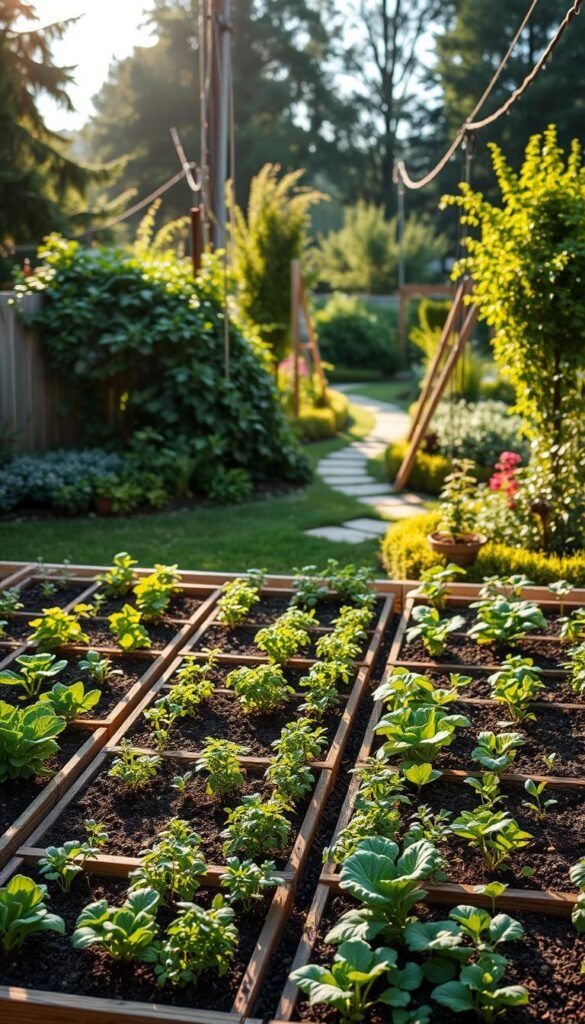Ever wondered how to grow more food in less space while saving time? Square foot gardening lets you do exactly that. This method divides planting areas into small, organized grids, maximizing every inch for fresh veggies, herbs, and flowers. Whether you’re new to growing or a seasoned pro, adapting your approach with the changing weather keeps plants thriving.
Why focus on seasonal adjustments? Plants have different needs as temperatures shift. Cool-weather crops like spinach flourish in spring, while tomatoes crave summer heat. Testing your soil and adding compost between seasons ensures nutrients stay balanced. Rotating crops prevents pests naturally, and proper spacing reduces competition for sunlight and water.
This guide walks you through each phase of the year. You’ll learn how to prepare beds efficiently, manage tools, and protect delicate roots during frost. Discover tips for boosting harvests through smart timing – like planting quick-growing radishes between slower veggies. Let’s make your growing space work smarter, not harder!
Key Takeaways
- Organized grid layouts maximize space and simplify maintenance
- Soil testing between seasons maintains nutrient-rich beds
- Strategic crop rotation reduces pest issues naturally
- Tailored watering techniques prevent waste
- Winterizing methods protect soil structure for spring
Getting Started with Square Foot Gardening
Small spaces can yield big harvests with the right strategy. This organized growing method uses 1×1-foot grids to simplify planning and boost productivity. You’ll spend less time weeding and more time enjoying crisp lettuce or juicy tomatoes.
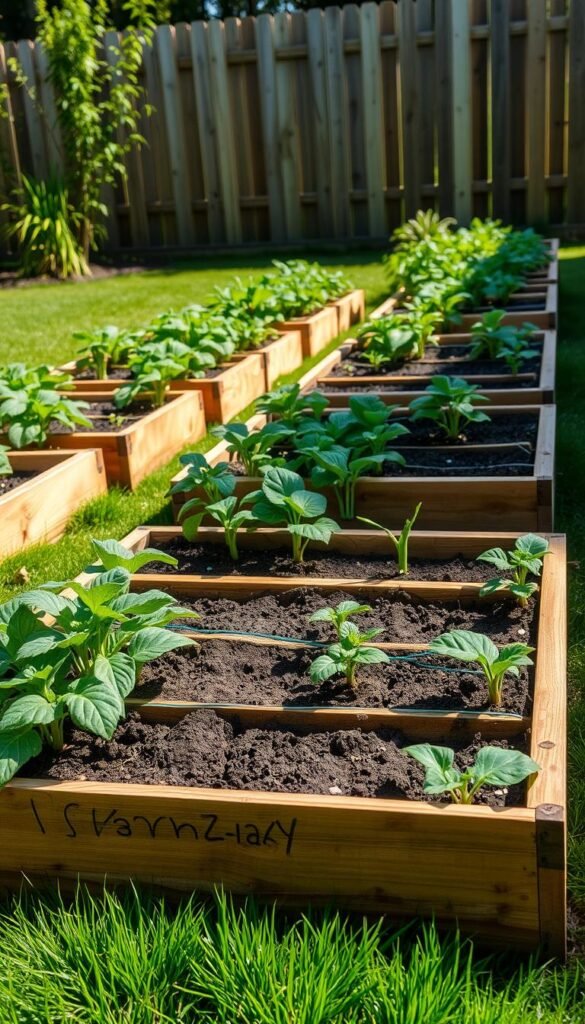
Why Grids Work Better
Dividing raised beds into squares stops overcrowding. Each section hosts one type of vegetable, herb, or flower. Group plants with similar water needs – like thirsty cucumbers or drought-tolerant rosemary – to avoid overwatering.
Mixing compost into your soil creates a nutrient-rich foundation. A 30% compost blend feeds roots while improving drainage. Test your soil each year to adjust pH levels and maintain fertility.
Designing Your Productive Space
Start with 4×4-foot beds for easy reach. Sketch a layout matching your local growing season. Cool-weather greens might fill spring squares, while summer heat-lovers like peppers claim their spots later.
Plan successive crops for continuous harvests. After pulling early radishes, plant bush beans in the same square. Vertical trellises save space for climbing peas or pole beans. Label each grid to track rotations and prevent pests.
This approach cuts water waste by targeting thirsty vegetables. You’ll nurture healthier plants while keeping tools and effort minimal. Ready to turn every square inch into something delicious?
Spring Garden Maintenance: Renew and Prepare
As frost retreats, your garden’s potential awakens – but where to begin? Early cleanup sets the stage for vigorous growth. Focus on three priorities: clearing remnants of cold weather, revitalizing soil, and planning crops that thrive in cool-to-warm transitions.
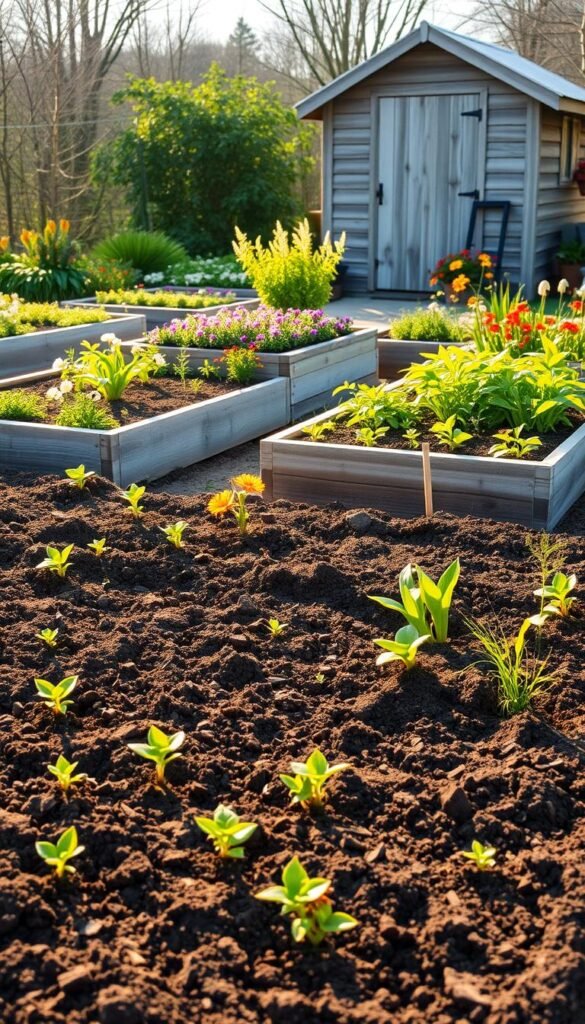
Clear the Canvas for New Growth
Start by removing fallen leaves, broken stems, and leftover mulch. Check for invasive weeds hiding near garden beds. Use handheld tools to avoid disturbing dormant roots. Trim overgrown branches blocking sunlight – this improves air circulation and prevents mold.
“A clean garden bed is like a blank page: what you write there determines your harvest story.”
Revive Your Soil’s Potential
Test soil temperature with a $10 probe – most spring crops need at least 45°F. Squeeze a handful of dirt: if it crumbles, it’s ready for planting. Mix in 2 inches of compost to replenish nutrients lost over winter. This way, you’ll create a fluffy base that retains moisture without waterlogging roots.
| Soil Amendment | Benefit | Best Time to Apply |
|---|---|---|
| Compost | Boosts microbial activity | 3 weeks before planting |
| Aged Manure | Adds slow-release nitrogen | Early spring |
| Leaf Mold | Improves water retention | After last frost |
Create a weekly guide for monitoring progress. Mondays: check soil moisture. Fridays: inspect for new weeds. This routine prevents overwhelm while keeping beds primed for success. By addressing these fundamentals, you’ll craft the ideal launchpad for peas, kale, and other cool-weather favorites.
Summer Garden Maintenance: Watering and Managing Heat
When temperatures soar, your grid-based growing space needs smart hydration strategies. Sun-scorched soil and thirsty roots demand precision – but overwatering drowns plants just as fast as neglect. Balance comes through timing, tools, and adapting to daily conditions.
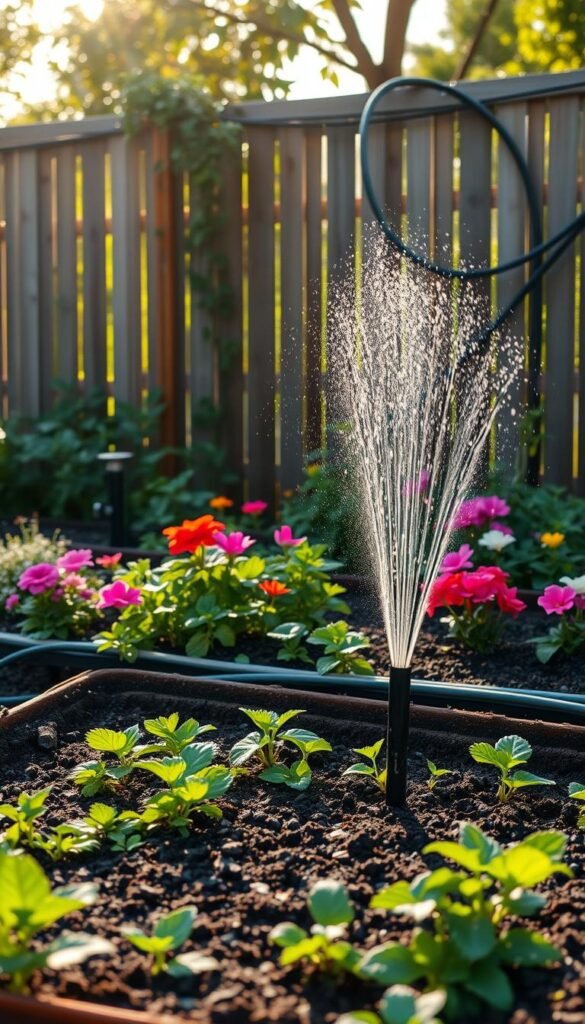
Efficient Watering Techniques for Your Square Foot Garden
Start mornings by hydrating plants before the sun climbs high. Early watering reduces evaporation by 40%, letting roots drink deeply. Use a drip irrigation system or soaker hoses to deliver moisture directly to soil – this prevents leaf scorch and fungal issues.
Mulch acts like a thermostat for your beds. Spread 2-3 inches of straw or shredded bark to keep soil cool and moist. Check moisture levels by sticking a finger 1 inch deep; if it’s dry, it’s time to adjust your watering schedule.
| Method | Best For | Water Savings | Setup Complexity |
|---|---|---|---|
| Drip Irrigation | Large beds, busy gardeners | 50-60% | Moderate |
| Soaker Hoses | Small spaces, tight budgets | 30-40% | Easy |
| Hand Watering | Seedlings, precise control | 10-20% | Time-consuming |
Shift planting times to avoid midday heat stress. Sow quick-growing seeds like arugula in late afternoon shade. Use shade cloth (30% density) over delicate greens during heatwaves. This protects tender leaves while letting enough light through.
Track weekly forecasts to tweak your system. Cut water by half during rainy spells, then boost when heat domes strike. Healthy roots now mean stronger plants that transition smoothly into winter prep later.
Fall Garden Maintenance: Harvest and Prepare for Winter
Autumn’s crisp air signals time to gather rewards and fortify beds for colder months. This season blends bounty with preparation – you’ll savor fresh produce while laying groundwork for next year’s success.
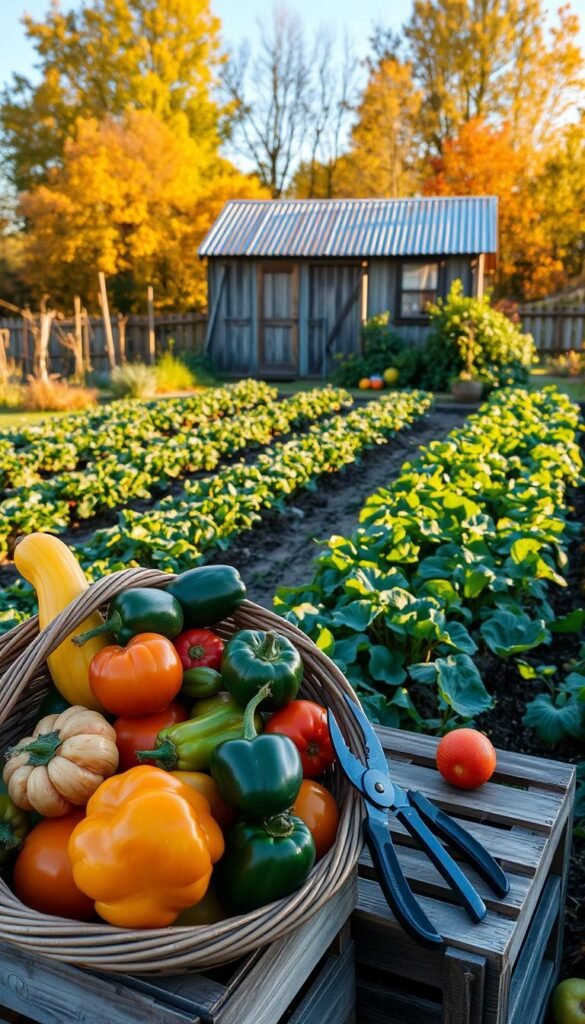
Maximizing Your Fall Harvest
Pick pumpkins when stems harden and skins resist fingernail scratches. Cut them with pruners to avoid vine damage. Leafy greens like spinach taste sweetest after light frosts. Harvest outer leaves first to keep plants productive.
Dig carrots once their shoulders reach ¾-inch diameter. Loosen soil gently to prevent snapping tender roots. Store them in damp sand for winter crunch. Check squash daily – a shiny rind means it’s not ready.
Planting Cool-Season Crops and Succession Strategies
Sow spinach and lettuce seeds 6 weeks before first frost. These greens thrive in 50-70°F soil. Use succession planting: replace harvested beans with quick-growing radishes or kale.
| Crop | Planting Depth | Days to Harvest |
|---|---|---|
| Spinach | ½ inch | 35-45 |
| Carrots | ¼ inch | 55-75 |
| Lettuce | ⅛ inch | 30-50 |
Mix compost into emptied squares to replenish matter. A 1-inch layer feeds microbes breaking down organic things. Rotate crops to new grids – this disrupts pests eyeing leftover plant debris.
Shield beds with row covers when frost threatens. These let light through while trapping warmth. Your lettuce and spinach will keep growing long after summer’s heat fades.
Winter Garden Maintenance: Protect Your Garden
Frosty mornings don’t mean your growing efforts stop – they shift focus. Smart winter strategies keep soil healthy, tools ready, and your green thumb active even when snow blankets your grids.
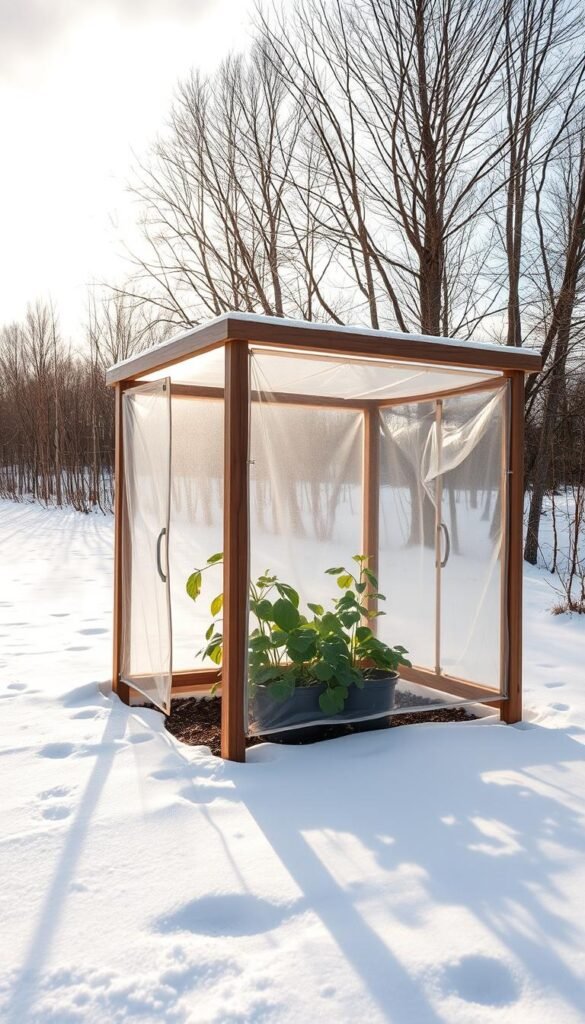
Shield Plants From Freezing Temperatures
Wrap vulnerable perennials like rosemary with frost blankets when temperatures drop below 28°F. Apply 4-6 inches of straw mulch around garlic and overwintering onions. This traps warmth while smothering dormant weeds in planting areas.
Clear debris from beds to prevent mold growth. Use burlap screens on windy sides of raised gardens. Check mulch depth monthly – replenish if heavy rains wash it away.
| Mulch Type | Best For | Application Timing |
|---|---|---|
| Straw | Root vegetables | After first hard frost |
| Pine Needles | Acid-loving plants | Late fall |
| Shredded Leaves | Flower beds | Before snowfall |
Thrive Indoors While Planning Ahead
Move potted herbs like basil to sunny kitchen windowsills. Water only when soil feels dry – overwatering kills more plants than cold. Scrub tools with vinegar to remove rust, then coat metal parts with mineral oil.
Sketch next year’s layout using seed catalogs. Try new varieties like purple carrots or dwarf kale. Start lettuce and microgreens indoors for fresh kitchen salads. This keeps your gardening rhythm steady until spring’s return.
Seasonal Care for Your Square Foot Garden: From Spring to Winter
Gardening success isn’t about constant effort—it’s about smart timing. By syncing your tasks with nature’s rhythm, you turn every inch of space into a powerhouse of fresh flavors. Whether nurturing crisp radishes in spring or juicy tomatoes in summer, each season offers unique rewards when you adapt your approach.
Your grid layout thrives when you treat each part of the year as a new chapter. Cool-weather crops demand early planting and frost protection, while summer varieties need heat management. Even a small lot of 16 squares can produce a lot of food if you rotate crops and refresh soil between cycles.
| Season | Key Task | Star Crop |
|---|---|---|
| Spring | Soil prep & cool-weather planting | Spinach |
| Summer | Targeted watering & pest checks | Tomatoes |
| Fall | Succession planting & harvests | Radishes |
| Winter | Soil insulation & tool care | Garlic |
Unpredictable weather? No problem. Mulch shields roots during droughts, while row covers extend fall harvests. Track rainfall to adjust watering—your plants will show gratitude through vibrant growth.
“A garden isn’t maintained—it’s danced with, season to season.”
Remember: those few inches between plants matter. Proper spacing prevents disease and lets sunlight reach every leaf. Stick to the plan, and you’ll see how each part of your garden contributes to a year-round feast. Ready to make next year your most abundant yet?
Year-Round Garden Tools and Tips
Sharp tools and smart habits keep your growing space thriving through every season. With the right steps, you’ll spend less time battling rust or pests and more time harvesting.
Maintaining Garden Tools and Equipment
Clean pruners after each use with rubbing alcohol to prevent spreading disease. Sharpen blades monthly using a file – smooth cuts heal faster on plants. Store tools in a dry shed or hang them on pegboards to avoid moisture damage.
“A well-oiled shovel works like a kitchen knife – it should slice through soil effortlessly.”
Integrated Pest Management and Disease Prevention
Spot aphids early by checking leaf undersides weekly. Introduce ladybugs to devour soft-bodied insects naturally. For fungal issues like powdery mildew:
- Remove infected leaves immediately
- Space plants for better airflow
- Apply neem oil at dusk
Rotate crops yearly using this simple list of plant families: nightshades (tomatoes), brassicas (kale), legumes (beans). This breaks pest cycles and preserves soil health.
Practical Succession Planting and Crop Rotation Insights
Follow these steps for continuous harvests:
- Map your grid layout each season
- Note which squares held heavy feeders (corn)
- Plant soil-restorers like peas next
| Previous Crop | Next Ideal Plant | Benefit |
|---|---|---|
| Tomatoes | Spinach | Rebuilds nitrogen |
| Carrots | Beans | Breaks pest cycles |
| Lettuce | Radishes | Prevents disease |
This work pays off – you’ll see fewer bugs and bigger yields. Keep a journal to track what grows best where, turning guesswork into strategy.
Conclusion
Your journey to a thriving garden begins with one organized square. By planning each growing season around raised beds and timed rotations, you’ll turn small spaces into abundant sources of fresh food. This method thrives on simplicity—whether you’re starting fresh or refining an existing setup.
Raised beds offer structure, while seasonal adjustments keep soil healthy. Remember: success comes from consistent care. Test nutrients after harvests, rotate crops to deter pests, and shield plants during extreme weather. These steps ensure your efforts yield results through every phase.
Ready to start? Review the strategies shared here. Make sure your tools are sharp, grids labeled, and compost stocked. Each action builds toward a resilient garden that adapts as temperatures shift.
You’ve got the blueprint. Now, transform those squares into a year-round haven. With each season’s lessons, your confidence—and harvests—will grow. Let’s get those hands dirty!

